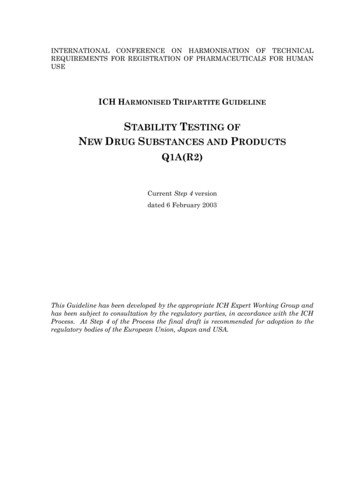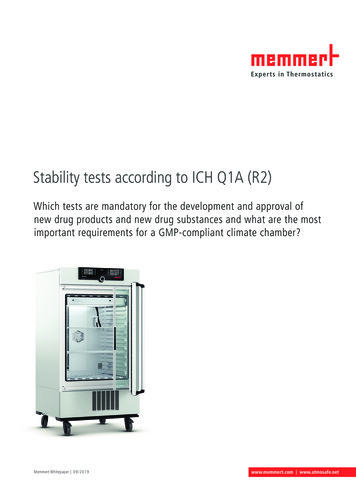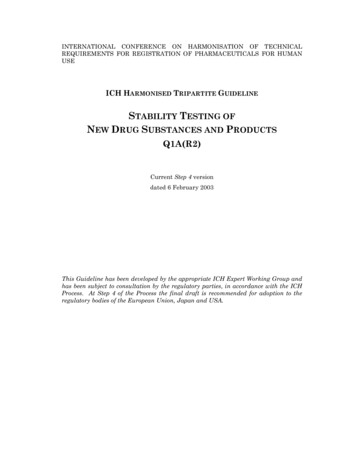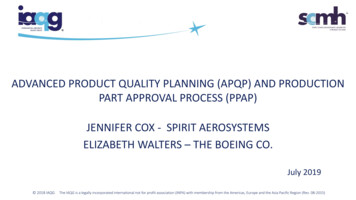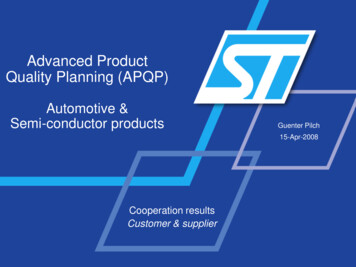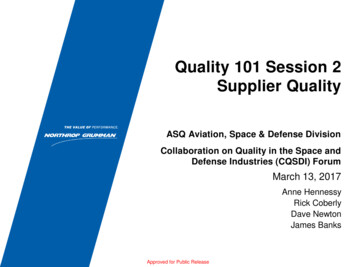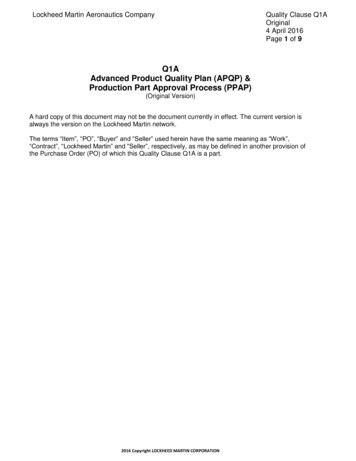
Transcription
Lockheed Martin Aeronautics CompanyQuality Clause Q1AOriginal4 April 2016Page 1 of 9Q1AAdvanced Product Quality Plan (APQP) &Production Part Approval Process (PPAP)(Original Version)A hard copy of this document may not be the document currently in effect. The current version isalways the version on the Lockheed Martin network.The terms “Item”, “PO”, “Buyer” and “Seller” used herein have the same meaning as “Work”,“Contract”, “Lockheed Martin” and “Seller”, respectively, as may be defined in another provision ofthe Purchase Order (PO) of which this Quality Clause Q1A is a part.2016 Copyright LOCKHEED MARTIN CORPORATION
Lockheed Martin Aeronautics CompanyQuality Clause Q1AOriginal4 April 2016Page 2 of 9Table of ContentsI.PURPOSE . 3II.SCOPE . 3III.RELEVANT DOCUMENTS . 3IV.ADVANCED PRODUCT QUALITY PLANNING REQUIREMENTS . 4V.PRODUCTION PART APPROVAL PROCESS REQUIREMENT . 8VI.PPAP FILE . 8VII.APQP/PPAP EXIT CRITERIA . 8VIII. RECORDS . 92016 Copyright LOCKHEED MARTIN CORPORATION
Lockheed Martin Aeronautics CompanyI.Quality Clause Q1AOriginal4 April 2016Page 3 of 9PURPOSEA. The purpose of the Advanced Product Quality Plan (APQP) process is for Seller to producea product quality plan to support development of a product and ensure on-time/on-qualitydelivery with zero defects to Buyer.B. An output of APQP is the Production Part Approval Process (PPAP). PPAP providesevidence that all Buyer engineering design record and specification requirements areproperly understood by Seller, and that Seller’s manufacturing process has the potential toproduce product that consistently meets all requirements during an actual production run atthe quoted production rate.Note: This Quality Clause is modeled after AIAG’s APQP/PPAP with distinctiverequirements found in the Aerospace Industry (AS/SAE Requirements) and InternationalAerospace Quality Group (IAQG) Supply Chain Management Handbook (SCMH).II.SCOPEA. The requirements of this Quality Clause are applicable in full to the PO and to all lower-leveldetail parts which comprise the part(s) on the PO. This includes parts/software/firmwaremanufactured, processed, assembled, tested, and/or inspected at sub-tier suppliers.B. This Quality Clause shall apply to new product development efforts and to productscurrently in production where changes are planned.C. This Quality Clause shall also continue to apply when previously approved products andprocesses undergo changes that affect Fit, Form and/or Function (e.g., introduction of a newproduction process, change to existing production process, change of production source,addition to the existing production sources, etc.).D. The following items do not require APQP/PPAP, unless otherwise directed by Buyer:1. Standard hardware and electronic piece parts (e.g., AN, MS & NAS standards; C, M& P standards; 2GNA00001 standard parts; etc.)2. Commercial off-the-shelf (COTS) itemsE. In the case of a conflict between other industry standards and this Quality Clause, thisQuality Clause takes precedence.F. For the interpretation of requirements and guidance in this document: The word “shall” indicates mandatory requirements. The word “should” indicates a recommendation. The words “example” and “for reference”, and the word “should” appearing in Notesections, are for guidance only. The word “Note” is used for additional clarification.III.RELEVANT DOCUMENTSIt is the responsibility of Seller to work to the latest version of the specifications referencedwithin this document and/or as indicated in the PO. It is the responsibility of Seller to obtaincopies of the non-LM documents specified herein. These include but may not be limited to thefollowing:2016 Copyright LOCKHEED MARTIN CORPORATION
Lockheed Martin Aeronautics CompanyQuality Clause Q1AOriginal4 April 2016Page 4 of 9LM Aero Documents:Appendix QX, Supplier Quality RequirementsExternal Documents:It is the responsibility of Seller to obtain copies of the non-LM documents specified herein.These include but may not be limited to the following:AS9100, Quality Management SystemAS9102, Aerospace First Article Inspection RequirementAS9103, Variation Management of Key CharacteristicsASTM 2782, Standard Guide for Measurement Systems Analysis (MSA)SAE J1739 Potential Failure Mode and Effects Analysis (Design FMEA, Process FMEA)AIAG APQP ManualAIAG PPAP ManualAIAG Measurement Systems Analysis (MSA) ManualIAQG Supply Chain Management Handbook (SCMH)IAQG Aerospace APQP ManualIV.ADVANCED PRODUCT QUALITY PLANNING REQUIREMENTSThe critical path in APQP consists of five phases along with ongoing feedback assessment andcorrective action as depicted pictorially in the Figure below. Seller is responsible to execute theAPQP and appropriately report the status to Buyer at the established frequency. It is Seller’sresponsibility to obtain industry standard documents such as the AIAG AQPQ Manual andSCMH Section 7.2 for additional guidance.2016 Copyright LOCKHEED MARTIN CORPORATION
Lockheed Martin Aeronautics CompanyQuality Clause Q1AOriginal4 April 2016Page 5 of 9A. Phase 1-Planning Requirements1. The goal of Phase 1 is to establish the framework of the project and product. Theactivities in this Phase should capture the building of the technical, quality, andmanufacturing requirements, the identification of the parts to be outsourced, thebuilding of the sourcing plan, and finally the building of the APQP timeline plan whichdescribes all APQP activities and the schedule aligned with the project needs.2. Seller shall identify and capture all technical and non-technical inputs applicable tothe product.3. Seller shall identify and capture all requirements from Buyer, regulatoryrequirements, benchmark data, lessons learned, company knowns and strategy.4. Seller shall include in the plan a timeline of the APQP and PPAP deliverableelements required by this Quality Clause, PO, and those identified by Seller.B. Phase 2-Product Design and Development Verification Requirements1. The goal of Phase 2 is to translate the product requirements, as determined inPhase I, into the product design. In this Phase the intended production processes,potential suppliers and production sources used to realize the product and to designkey characteristics are identified.2. Seller shall ensure that a design risk analysis related to performance (i.e., fit, form,and function), durability, service life, reliability, manufacturability, maintainability, andcost is performed, and that appropriate risk mitigation activities are identified,prioritized, and completed.3. Design Failure Modes and Effects Analysis (DFMEA)DFMEA assists in the identification of key design characteristics, helps prioritizeaction plans for mitigating risk, and serves as a repository for lessons learned.Seller shall produce a DFMEA when Seller is product design-responsible (referenceSAE J1739).Note: DFMEA is a living document and should be updated accordingly, and reviewedperiodically. A single design FMEA can be applied to a family of parts.4. Product Critical items (CI) and Key Characteristic (KC)KCs and CIs identified through the risk analysis shall be incorporated into the designrecords (reference AS 9103).C. Phase 3-Process Design and Development Verification Requirements1. In Phase 3 the process which will be used to manufacture the product is designedand developed. The manufacturing process shall be designed and developed toensure that Buyer’s requirements, the design requirements, and the manufacturingorganization’s requirements can be met consistently both within Seller’s internalmanufacturing operations and by Seller’s suppliers.2. Process Flow Diagram2016 Copyright LOCKHEED MARTIN CORPORATION
Lockheed Martin Aeronautics CompanyQuality Clause Q1AOriginal4 April 2016Page 6 of 9Seller shall have a process flow diagram that includes all operations in sequentialorder from receipt of materials through storage and shipment of finished product.This encompasses alternate process flows and movement of product to and fromexternal operations.Note 1: Within the process flow diagram, there shall be sufficient detail of theproduction process steps and sequence.Note 2: Process flow diagrams for families of similar parts are acceptable if the newparts have been reviewed for commonality by Seller.3. Process Failure Mode & Effect Analysis (PFMEA)The PFMEA assists in the identification of key process characteristics, helpsprioritize action plans for mitigating risk, and serves as a repository for lessonslearned.Seller shall develop a Process FMEA (reference SAE J1739).Note: A single process FMEA may be developed for a family of similar parts ormaterials, provided a formal review of risk priority numbers is performed for Buyerparts to ensure product will meet intended specification(s).Note: FMEA is a living document and should be updated accordingly, and reviewedperiodically (periodic review at least annually).4. Process Control PlanSeller shall develop a Process Control Plan that defines all methods used forprocess control and shall include a comprehensive reaction plan (referenceAS9103).Note: Process Control Plan is a living document and should be updated accordingly,and reviewed periodically (periodic review at least annually).5. Process Key Characteristics (KC)Process KCs are attributes or features whose variation has a significant influence onproduct fit, performance, service life, or producibility; and that require specific actionfor the purpose of controlling variation (reference AS9103).Where there are no Buyer identified process KCs, then Seller shall identify processKCs using PFMEA or other sufficient methods in order to establish variation controlof product KCs and CIs.Key product/process characteristics shall be traceable from their originatingdocument through the process flow, PFMEA, and control plan.Seller shall establish the frequency of process KC review for elimination and/or KCaddition.6. Measurement Systems Analysis (MSA) PlanSeller shall develop a Measurement Systems Analysis (MSA) Plan. The plan shallestablish the analytical methods and acceptance criteria for gages, checking aids,and inspection equipment that require the MSA and the frequency of the MSA to beperformed.2016 Copyright LOCKHEED MARTIN CORPORATION
Lockheed Martin Aeronautics CompanyQuality Clause Q1AOriginal4 April 2016Page 7 of 97. Manufacturing Process DocumentationSeller shall have controlled documented manufacturing work instructions and visualaids available for each process and at point of use.D. Phase 4-Product and Process Validation Requirements1. The goal of Phase 4 is for Seller to demonstrate that the manufacturing andassembly processes can produce conforming product at the required rate.2. Measurement Systems Analysis MSAAt a minimum, Seller shall perform an MSA on the measurement methods for KCs(product and process) identified in the Control Plan (reference ASTM E2782). Actionplans are required when MSA results are not satisfied.NOTE 1: Applicable MSA studies can be established using various methods (e.g.,bias studies, Gage Repeatability and Reproducibility (Gage R&R), repeatabilitystudy, measurement uncertainty analysis, and attribute agreement analysis).NOTE 2: Seller shall demonstrate that all measurement methods and checking aidsincluded in the Control Plan are suitable and capable.3. Preliminary Process CapabilitySeller shall perform initial process capability studies using industry recognizedstatistical methods. These studies shall be completed for product and process KCsidentified within the design record and Seller Control Plan (reference AS9103).Note: Where no KCs have been identified by Buyer, Seller shall identify KCs anddemonstrate initial process capability.4. First Article Inspection (FAI)Seller shall perform FAI (reference AS9102) to validate that product realizationprocesses are capable of producing parts and assemblies that meet engineering anddesign requirements. The FAI shall provide objective evidence that Seller’sprocesses can produce compliant product and that Seller has understood andincorporated associated requirements.Seller shall perform FAI per Buyer’s Appendix QX.E. Phase 5- On Going Production1. Phase 5 extends throughout the lifecycle of the product and consists of activities thatare performed post product qualification. These activities should include but not belimited to defect reduction, improved cycle time, product improvements, and costreductions. As these issues/opportunities arise, the process and controls establishedand validated in Phases 2-4 shall be reviewed and updated as necessary by Sellerto address them.2. Variation Reduction (Preventive Action)Seller shall establish a variation management system to monitor processes, withspecial attention given to Buyer and Seller identified KCs (reference AS9103).2016 Copyright LOCKHEED MARTIN CORPORATION
Lockheed Martin Aeronautics CompanyQuality Clause Q1AOriginal4 April 2016Page 8 of 93. Product Quality Assurance (Corrective Action)Seller shall ensure that products continuously conform to all requirements. Sellershall establish a means for monitoring the product performance, and shall takeaction to determine root cause and implement corrective/preventative
The purpose of the Advanced Product Quality Plan (APQP) process is for Seller to produce a product quality plan to support development of a product and ensure on-time/on-quality delivery with zero defects to Buyer. B. An output of APQP is the Production Part Approval Process (PPAP). PPAP provides evidence that all Buyer engineering design record and specification requirements are properly .
